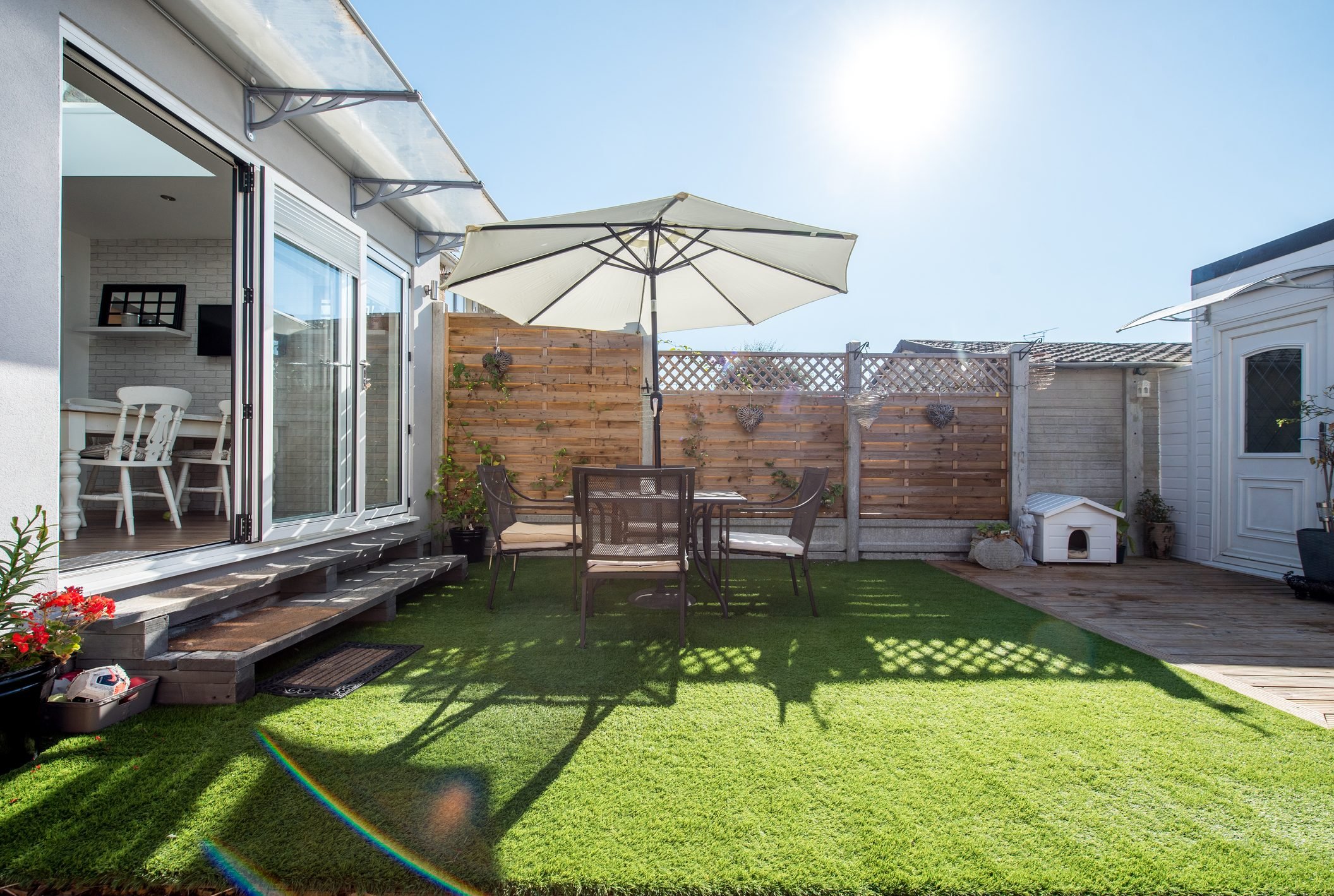Considering artificial grass? Will this low-maintenance lawn option work in your yard? Here's what you need to know.

How To Choose the Right Artificial Grass for Your Yard

I love to garden, but I’m not much of a mower. It’s monotonous, and when it’s 110 degrees outside, I usually spend the time fantasizing about ripping up all the grass and planting cacti and rocks.
But what about artificial grass? I spoke with Joe Raboine, vice president of design at Belgard, to get the details on this low-maintenance and increasingly popular lawn option.
Gone are the days of ugly, hard plastic turf. Raboine says today’s styles fit every aesthetic and budget, so do your research. If you’ve considered installing artificial grass, we’ve got the info you need to make a decision.
On This Page
What Is Artificial Grass?
Artificial grass, also called artificial turf, is a synthetic replacement for real turfgrass. Originally used to replace real grass in sporting venues, artificial grass is becoming popular in residential settings due to its easy maintenance, durability and year-round beauty.
Types of Artificial Grass
Artificial grass comes in dozens of styles based on color, thatch, pile height and density. But the turf itself is generally made from three main materials:
- Nylon: “Nylon turf is the strongest and holds up the best in hot or cold climates,” Raboine says, “but is typically the stiffest to the touch and expensive.” Nylon also absorbs water, which can be a negative.
- Polyethylene: “Polyethylene is the most premium option because of its more natural look and texture,” Raboine says. Polyethylene is nonporous, durable and stands up to the elements.
- Polypropylene: The most cost-effective of the three turfs, it doesn’t maintain its shape like the others. It also doesn’t hold up to high heat or lots of traffic. Raboine recommends this option for aesthetics only.
Raboine suggests choosing a medium-density, medium-pile height artificial grass with some “thatch” mixed in. “This will provide the most natural appearance and won’t break your budget,” he says. Make sure you see actual samples at your home before you buy.
Best Use Cases for Artificial Grass
Taking care of a natural lawn requires work. Mowing, fertilizing, watering … it’s no wonder Raboine says the No. 1 reason people install artificial grass in their yard is ease of maintenance. It’s not picky about the weather, either. “Turf is a great option,” Raboine says, “as it always looks great, no matter the conditions.”
If you’ve got any of these backyard situations, artificial turf could be a good choice:
Excess shade
Natural turfgrasses, even shade varieties, need some sunlight. If you’ve tried to grow a lush lawn only to see shadows interfere, artificial grass won’t mind being “planted” under tree cover or in the shade of a building.
Dry climate
In places that don’t get a lot of rain, it’s hard to grow grass without spending a fortune on your water bill. Irrigating your lawn in many parts of the country isn’t sustainable, either. Installing artificial grass means you can say goodbye to watering altogether.
Small yard
Are you sick of hauling out the mower for your little postage-stamp city lawn? Is that machine you use 10 minutes a week taking up valuable space in the garage? Artificial grass can be a practical, convenient choice for homeowners with small yards.
Hard-to-mow yards
I used to lift my lawn mower up five steps every time I mowed. As a result, I mowed less than my neighbors probably liked. (I was helping the bees!) For multi-level lawns and other hard-to-mow yards, artificial grass makes sense.
Climate Considerations for Artificial Grass
Raboine says artificial grass can handle just about anything — heavy snow, lots of trees, high humidity and regular downpours. “These factors won’t impact the longevity of the turf,” Raboine says. They will, however, require different maintenance.
Tree cover
Those beautiful shade trees will keep your artificial grass cool all summer, but you’ll need to remove tree debris regularly. Leaves, sticks and acorns break down and embed themselves in the thatch, becoming difficult to remove if you let it go all season. Use a leaf blower or even a shop vacuum for this task.
“A blower works really well and should be done often if you have trees and debris overhead,” Raboine says.
Heavy snow
Before winter sets in, be sure to remove as much lawn debris as possible. If you won’t walk on the artificial grass all winter, Raboine says it’s best to just let snow and ice naturally melt.
If you need to use the space to walk or take pets out, buy a plastic snow shovel without a metal edge to gently remove the snow. A push broom works well, too.
Hot climates
Artificial grass works in any climate, but direct penetrating sunlight can make the turf unbearably hot. If you have children or pets, keep this in mind. Here’s our collection of the best artificial grass for dogs.
Higher-quality artificial grasses will absorb less heat than cheaper ones. Consider installing shade trees or other landscaping features to break up a huge stretch of exposed artificial turf.
“Choosing a high-quality UV-resistant turf will ensure longevity,” Raboine says.
Rain and humidity
The best thing about artificial grass? You don’t have to water it. Rain and humidity don’t faze it, either. But good drainage is essential. That’s why artificial turf costs more up front. Preparing the ground underneath with decomposed granite and sand takes work, but allows water to flow down and through.
“Polyethylene products with nylon backing — with drain holes — are preferred in most cases,” Raboine says.




















